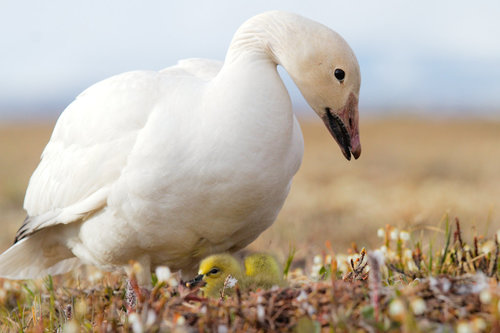
Snow Goose
The Snow Goose (*Anser caerulescens*) is a North American species of goose known for its striking white plumage (in the white morph) and massive migrations. It plays a significant ecological role as a grazer, influencing tundra and wetland vegetation. Historically, the Snow Goose has been a crucial resource for indigenous peoples and continues to be a popular game bird. Its populations have fluctuated dramatically, creating both conservation challenges and opportunities.
64-79 cm
Length
135-165 cm
Wingspan
Least Concern
Conservation Status
Distribution
Breeds in the Arctic regions of North America (Alaska, Canada, Greenland) and eastern Siberia. Winters in southern North America, including the southern United States and Mexico. Migrates through central North America along major flyways.
Lifespan
8-10 years in the wild, up to 20 years in captivity.
Snow Goose's Habitat
Habitat Types
Arctic tundra (breeding), Coastal marshes, Saltwater bays, Freshwater marshes, Agricultural fields (wintering)
Climate Zones
Arctic, Subarctic, Temperate
Adaptations
Dense down feathers for insulation in cold Arctic environments. Strong legs and bill adapted for grazing and digging for roots and tubers.
Variations
Two subspecies are generally recognized: the Lesser Snow Goose (*A. c. caerulescens*) and the Greater Snow Goose (*A. c. atlanticus*). The Greater Snow Goose is slightly larger and breeds in northeastern Canada and Greenland.
Appearance
Breeding Plumage
Two color morphs exist: white and blue. White morphs are almost entirely white with black wingtips. Blue morphs have a white head, dark brown-grey body, and white undertail coverts. Plumage is similar in breeding and non-breeding seasons.
Seasonal Feather Changes
Minimal seasonal variation.
Sex Based Plumage Differences
No significant sexual dimorphism in plumage.
Notable Features
Black 'grinning patch' on the bill (caused by the shape of the bill), Pink legs and feet, White morph is predominantly white with black wingtips, Blue morph has a dark body and white head
Diet and Feeding
Primary Foods
Grasses, Sedges, Rushes, Grains (especially during migration and winter), Roots, Tubers
Foraging Behavior
Primarily grazes on land, often in large flocks. Also feeds by grubbing for roots and tubers in shallow water or mud.
Specializations
Serrated edges on the bill help to efficiently cut and consume vegetation.
Seasonal Diet Variations
In the breeding season, feeds heavily on tundra vegetation. During migration and winter, consumes agricultural grains and waste crops when available.
Behavior
Social Structure
Highly social, forming large flocks outside of the breeding season. Breeds in colonies, often with thousands of nests.
Communication
Loud, honking calls, Head-bobbing, Wing-flapping, Neck-stretching
Migration
Migrates long distances between breeding and wintering grounds. Flies in large V-formations or irregular lines, often at high altitudes.
Territorial or Group Behaviors
Defends a small area around the nest during the breeding season. Forms large feeding and roosting flocks during migration and winter.
Conservation
Threats
Habitat degradation on breeding grounds (due to climate change and industrial development), Overgrazing of tundra vegetation in some areas, Hunting (regulated), Changes in agricultural practices (affecting food availability during migration)
Protection Programs
Migratory Bird Treaty Act (US and Canada), Monitoring of populations and hunting regulations, Habitat conservation efforts in some breeding and wintering areas
Local National Laws
Protected under the Migratory Bird Treaty Act in the United States and Canada.
Population Trend
Increasing overall, although some populations are of concern due to habitat degradation.
Population Estimates
Estimated at over 15 million birds.
Interesting Facts
Snow Geese can travel thousands of miles during migration.
They are strong fliers and can cover vast distances between their breeding and wintering grounds.
The blue morph was once considered a separate species.
It is now known to be a color variation of the Snow Goose.
Large flocks of Snow Geese can significantly alter tundra vegetation.
Their grazing and grubbing activities can impact plant communities.
Goslings can walk and swim within hours of hatching.
This precocial development is an adaptation to the harsh Arctic environment.
Faqs about Snow Goose
What is the difference between a Snow Goose and a Ross's Goose?
Ross's Geese are smaller than Snow Geese and lack the black 'grinning patch' on the bill. Their bill is also shorter and stubbier.
Are Snow Geese endangered?
No, Snow Geese are classified as Least Concern by the IUCN. Their populations have increased significantly in recent decades.
Where can I see Snow Geese?
During migration and winter, they can be seen in large numbers in wetlands, agricultural fields, and coastal areas across North America. In the summer, they are found in the Arctic tundra.
Do Snow Geese mate for life?
Snow Geese typically form long-term pair bonds, often lasting for many years, but 'divorce' can occur, particularly if breeding attempts are unsuccessful.
Copyright @ Nature Style Limited. All Rights Reserved.
 English
English